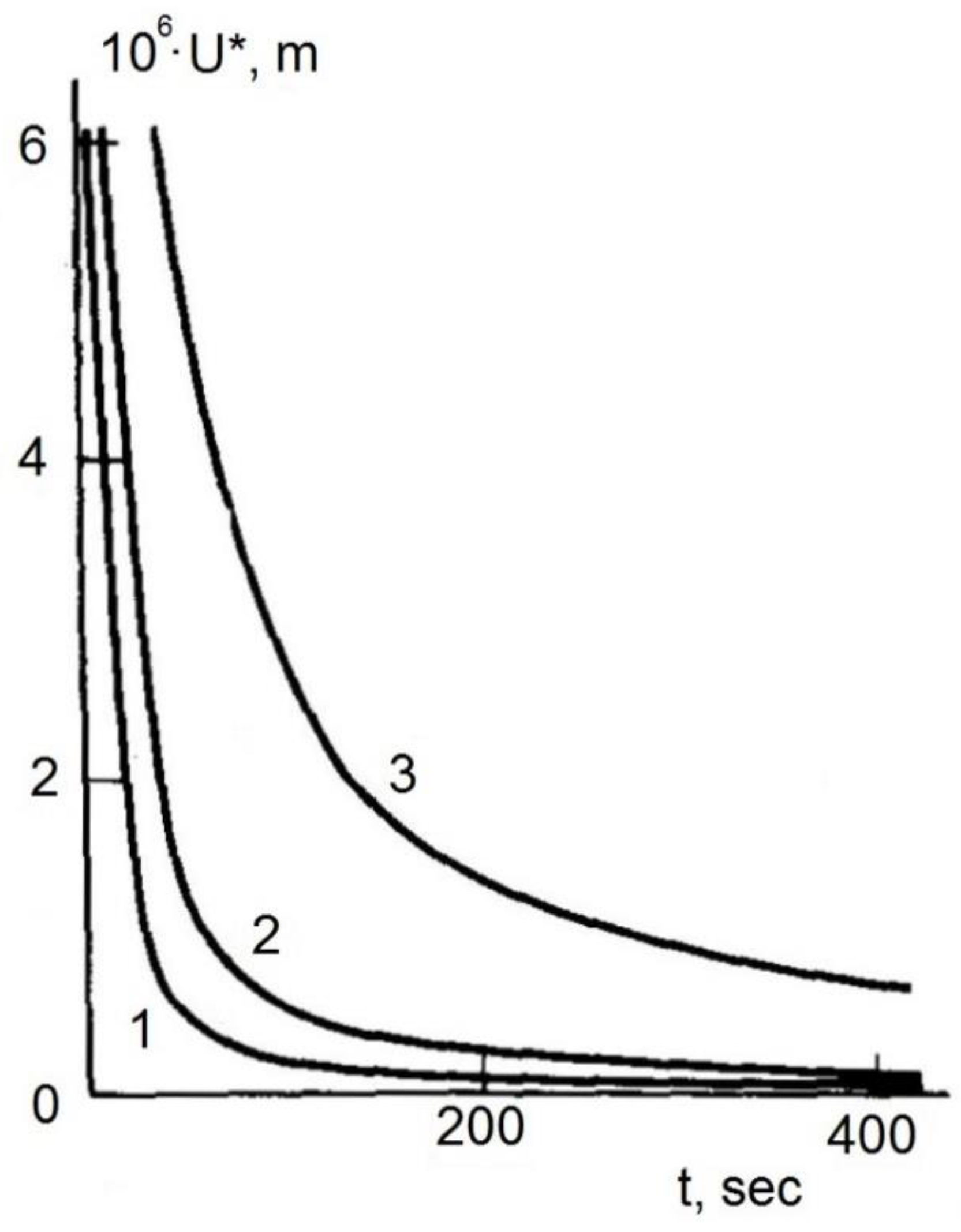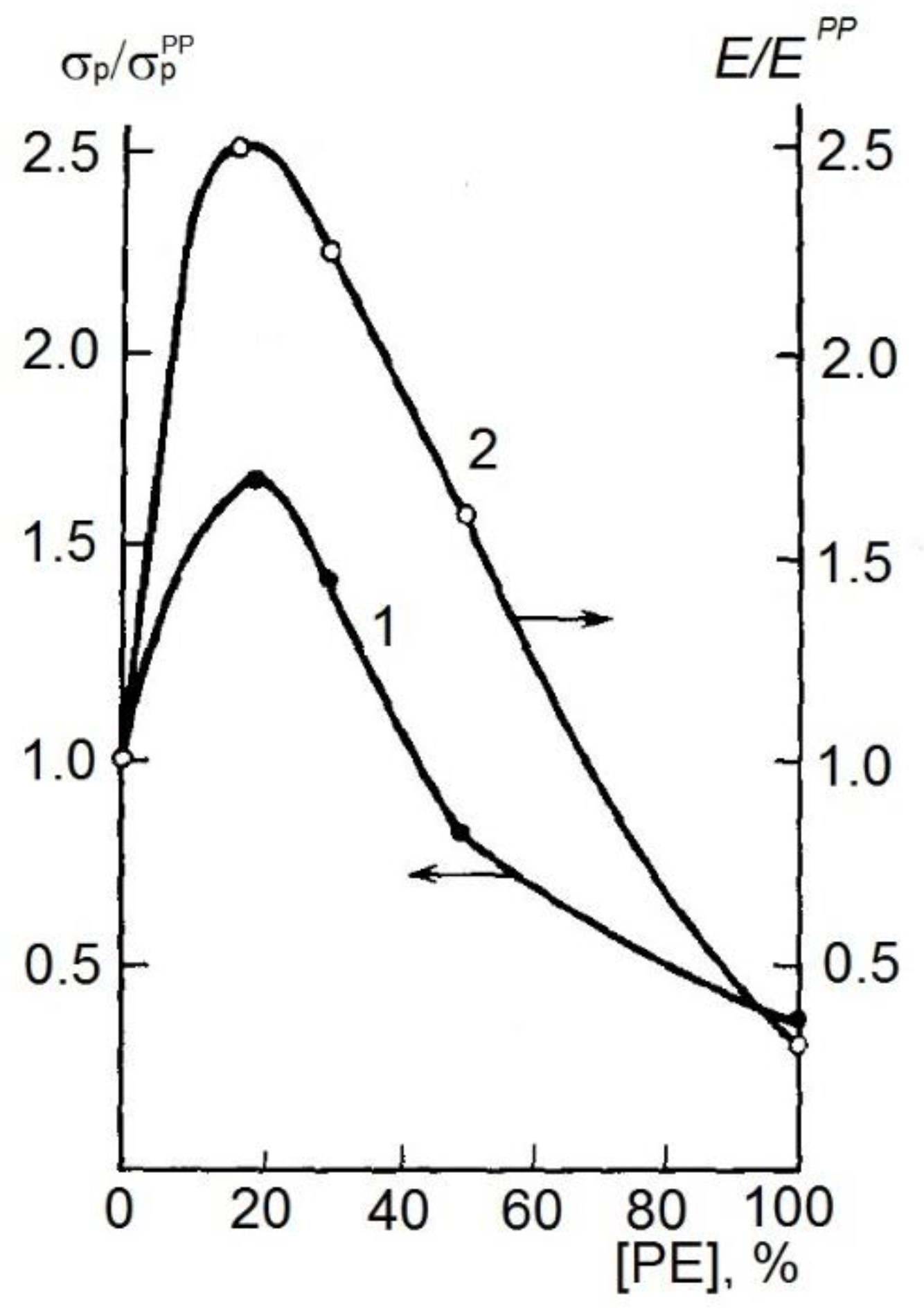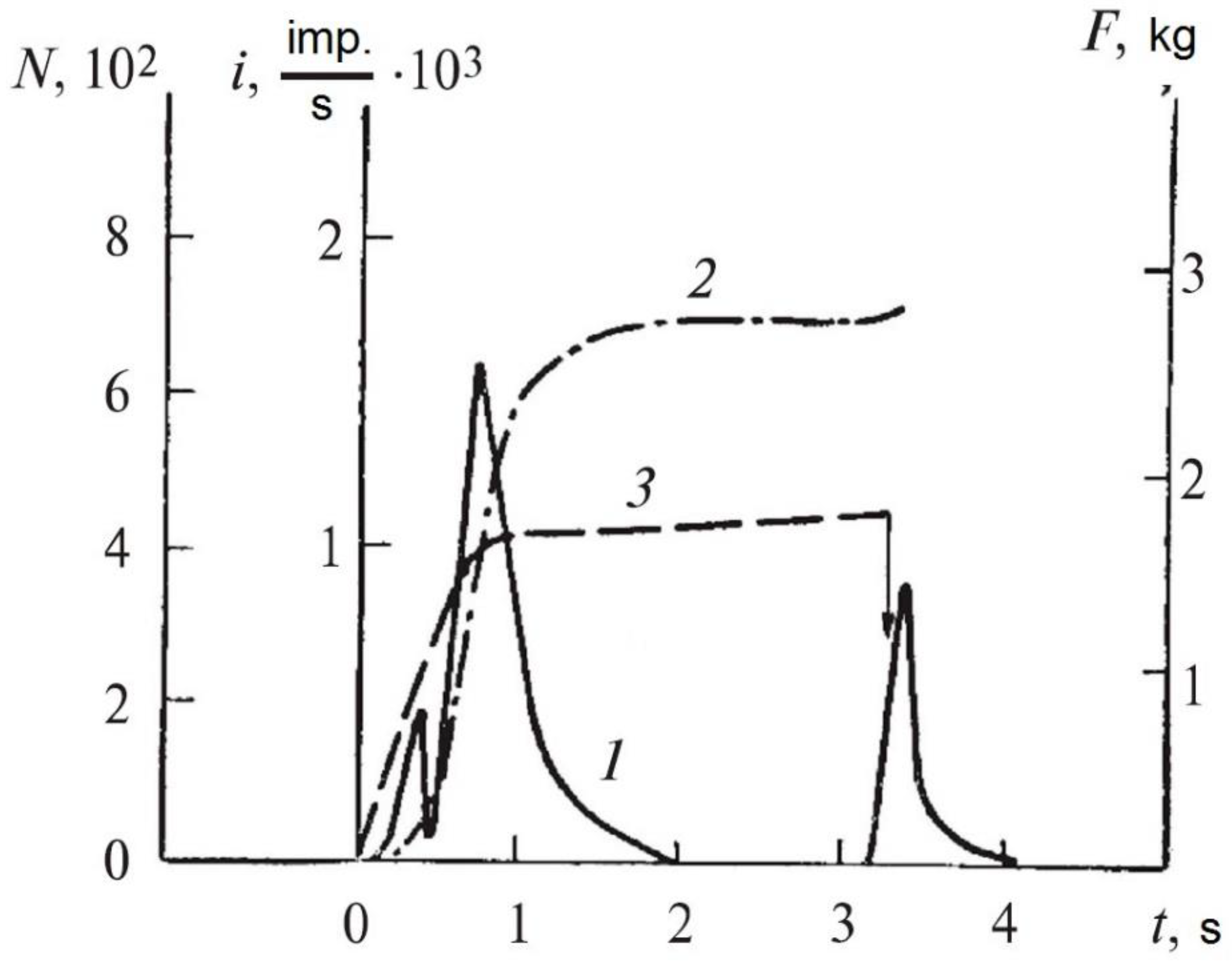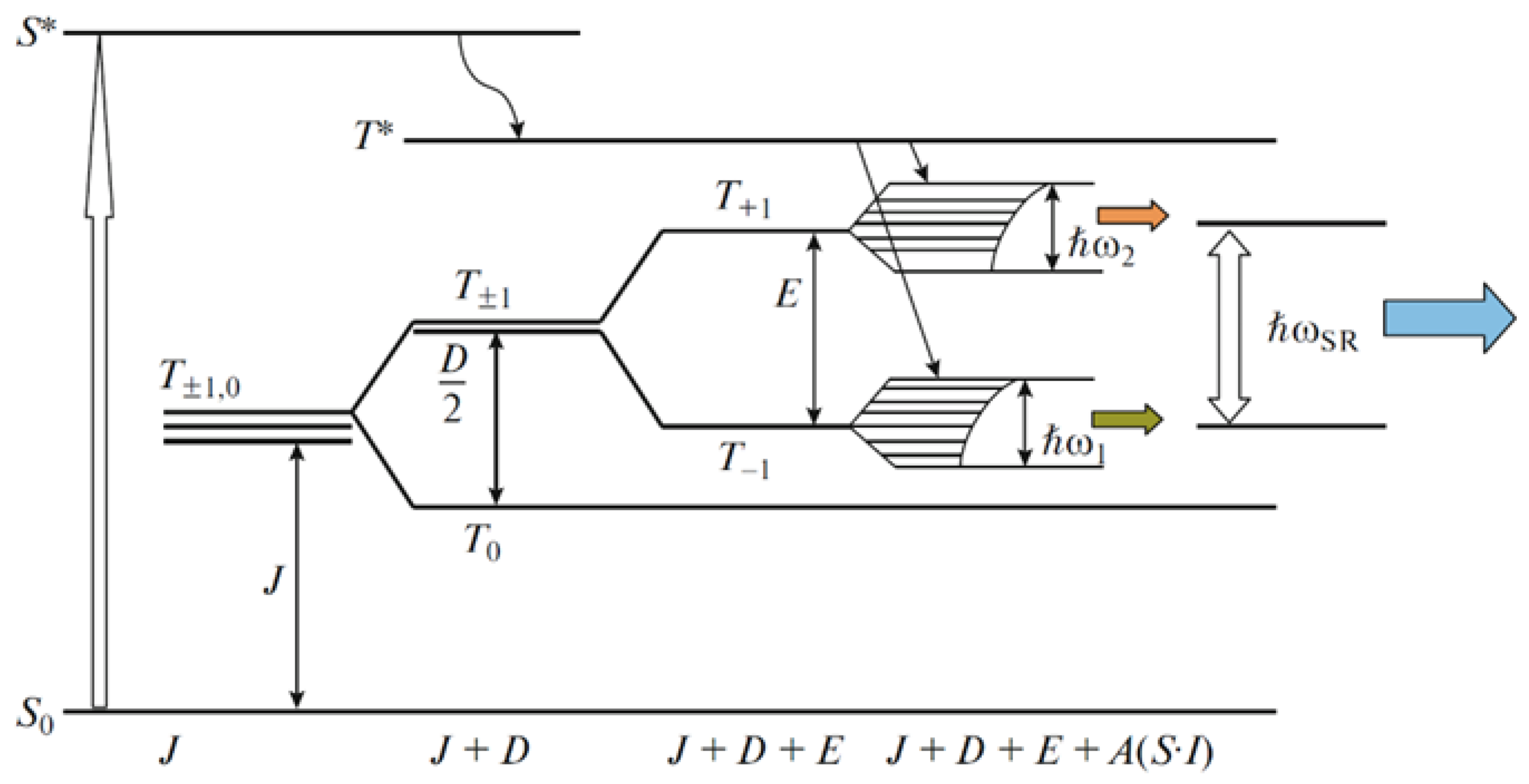Action of Mechanical Forces on Polymerization and Polymers
Abstract
:1. Introduction
2. The Main Directions of Research in the Mechanochemistry of Polymers and Their Current State
- (1)
- Study of the mechanisms and energy of chemical transformations in various mechanical fields.
- (2)
- The use of mechanochemical reactions for the synthesis and modification of polymer materials.
- (3)
- Search for ways to inhibit undesirable mechanochemical side processes that cause a drop in strength, increased wear and premature failure of various parts and structures made of polymer materials during their operation in static and dynamic mechanical fields.
- Study of physico-chemical processes occurring in natural polymers, their supramolecular complexes and biological materials during mechanochemical processing in laboratory and industrial conditions [23];
- Obtaining information about the influence of the chemical composition, surface properties, crystal and supramolecular structures of carbohydrate, protein and polyphenolic polymers on their reactivity in heterogeneous reactions, which follow mechanochemical processing [24];
- Finding the conditions of mechanochemical processing of protein macromolecules, to ensure the stability of proteins and leading to the formation of reactive composites with carbohydrate polymers and vegetable raw materials in general [25];
- Investigation into the behavior of nanocomposites and micro-composites based on polystyrene under conditions of rapid compression and identification of the role of mechanical action in the combined thermomechanical process [26];
- Carrying out the mathematical modeling of vibration effects on the kinetics of solid-phase decomposition reactions in condensed media to develop models of the mechanism and reveal the role of mechanical action in the combined mechanochemical process [27];
- Systematization of macroscopic manifestations of polymer mechanochemistry and evaluation of results in the framework of physical chemistry [5].
3. Chemical and Technological Aspects of Mechanochemical Transformations of Polymers
4. Actual Sources and Means for the Implementation of Mechanochemical Effects
- (1)
- The rate of chemical transformation in solids during shear deformation is very high and 3–8 orders of magnitude higher than the rate in the liquid phase;
- (2)
- There is no need to use a catalyst for the reaction to proceed;
- (3)
- The yield of the chemical reaction is proportional only to the magnitude of the shear strain, and the rate of the chemical reaction is proportional to the rate of deformation;
- (4)
- It turned out that there is no reason to use the generally accepted concept of the diffusion coefficient to quantify the mass transfer rate. If we use the “concept of reduced diffusion coefficient”, then we can make sure that its value at the moment of shear is 8–10 orders of magnitude higher than without shear deformation and 3–5 orders of magnitude greater than the diffusion coefficient of the same molecules at the same temperature in the liquid phase.
5. Current Concepts of the Mechanism of the Initial Stages of Mechanochemical Reactions and Their Development
6. Current Topical Trends in Mechanochemistry of Polymers
6.1. Mechanophores as Indicators of Mechanochemical Transformations of Polymers
6.2. New Physical Phenomena Accompanying External Mechanical Effects on Polymers and Relative Substances
7. Conclusions
- (1)
- Study of the mechanisms and energy of chemical transformations in various mechanical fields;
- (2)
- The use of mechanochemical reactions for the synthesis and modification of polymer materials;
- (3)
- Search for ways to inhibit undesirable mechanochemical side processes that cause a drop in strength, increased wear and premature failure of various parts and structures made of polymer materials during their operation in static and dynamic mechanical fields.
Author Contributions
Funding
Institutional Review Board Statement
Informed Consent Statement
Data Availability Statement
Conflicts of Interest
Abbreviations
| E | elastic modulus |
| Ekin | kinetic energy |
| Evib | vibration energy |
| U* | amplitude of acoustic waves |
| U | elastic energy |
| ΔL | tensile modulus |
| σp | tensile strength |
| AFM | atomic force microscopy |
| ATRP | atom transfer radical polymerization |
| ESR | electron spin resonance |
| MP | mechanophore |
| MW | molecular weight |
| Pa | Pascal |
| PE | polyethylene |
| PDMS | polydimethylsiloxane |
| PMA | poly(methyl acrylate) |
| PMMA | polymethyl methacrylate |
| SDDAC | structure-deformation diamond anvil cell |
| SMFS | single-molecule force spectroscopy |
| SPD | surface plastic deformation |
References
- Deneke, N.; Rencheck, M.L.; Davis, C.S. An engineer′s introduction to mechanophores. Soft Matter 2020, 16, 6230–6252. [Google Scholar] [CrossRef] [PubMed]
- Chen, Y.; Mellot, G.; van Luijk, D.; Creton, C.; Sijbesma, R.P. Mechanochemical tools for polymer materials. Chem. Soc. Rev. 2021, 50, 4100–4140. [Google Scholar] [CrossRef] [PubMed]
- Ghanem, M.A.; Basu, A.; Behrou, R.; Boechler, N.; Boydston, A.J.; Craig, S.L.; Lin, Y.J.; Lynde, B.E.; Nelson, A.; Shen, H.; et al. The role of polymer mechanochemistry in responsive materials and additive manufacturing. Nat. Rev. Mater. 2021, 6, 84–98. [Google Scholar] [CrossRef]
- Doerr, A.M.; Burroughs, J.M.; Gitter, S.R.; Yang, X.; Boydston, A.J.; Long, B.K. Advances in polymerizations modulated by external stimuli. ACS Catal. 2020, 10, 14457–14515. [Google Scholar] [CrossRef]
- Akbulatov, S.; Boulatov, R. Experimental polymer mechanochemistry and its interpretational frameworks. Chem. Phys. Chem. 2017, 18, 1422–1450. [Google Scholar] [CrossRef] [Green Version]
- Izak-Nau, E.; Campagna, D.; Baumann, C.; Göstl, R. Polymer mechanochemistry-enabled pericyclic reactions. Polym. Chem. 2020, 11, 2274–2299. [Google Scholar] [CrossRef] [Green Version]
- Hu, H.; Ma, Z.Y.; Jia, X.R. Reaction cascades in polymer mechanochemistry. Mater. Chem. Front. 2020, 4, 3115–3129. [Google Scholar] [CrossRef]
- Liu, Y.; Vancso, G.J. Polymer single chain imaging, molecular forces, and nanoscale processes by Atomic Force Microscopy: The ultimate proof of the macromolecular hypothesis. Prog. Polym. Sci. 2020, 104, 101232. [Google Scholar] [CrossRef]
- De Bo, G. Mechanochemistry of the mechanical bond. Chem. Sci. 2018, 9, 15–21. [Google Scholar] [CrossRef] [Green Version]
- Zaborniak, I.; Chmielarz, P. Ultrasound-mediated atom transfer radical polymerization (ATRP). Materials 2019, 12, 3600. [Google Scholar] [CrossRef] [Green Version]
- Zhou, Y.N.; Li, J.J.; Wu, Y.Y.; Luo, Z.H. Role of external field in polymerization: Mechanism and kinetics. Chem. Rev. 2020, 120, 2950–3048. [Google Scholar] [CrossRef]
- Mason, T.; Luche, J. Ultrasound as a New Tool for Synthetic Chemistry. In Chemistry under Extreme or Non-Classical Condition; van Eldik, R., Hubbard, C.D., Eds.; Wiley: Heidelberg, Germany, 1996; pp. 317–380. [Google Scholar]
- Price, G. Application of High Intensity Ultrasound in Polymer Chemistry. In Chemistry under Extreme or Non-Classical Condition; van Eldik, R., Hubbard, C.D., Eds.; Wiley: Heidelberg, Germany, 1996; pp. 381–427. [Google Scholar]
- Hoffmann, M.R.; Hua, I.; Hochemer, R.; Willberg, D.; Lang, P.; Kratel, A. Chemistry under Extreme Conditions in Water Induced Electrohydraulic Cavitations and Pulsed-Plasma Discharges. In Chemistry under Extreme or Non-Classical Condition; van Eldik, R., Hubbard, C.D., Eds.; Wiley: Heidelberg, Germany, 1996; pp. 429–478. [Google Scholar]
- Ponomarenko, A.T.; Tameev, A.R.; Shevchenko, V.G. Synthesis of polymers and modification of polymeric materials in electromagnetic fields. Russ. Chem. Rev. 2018, 87, 923–949. [Google Scholar] [CrossRef]
- Balaz, P. Mechanochemistry in Nanoscience and Mineral Engineering; Springer: Berlin/Heidelberg, Germany, 2008. [Google Scholar]
- Caruso, M.M.; Davies, D.A.; Shen, Q.; Odom, S.A.; Sottos, N.R.; White, S.R.; Moore, J.S. Mechanically induced chemical changes in polymeric materials. Chem. Rev. 2009, 109, 5755–5798. [Google Scholar] [CrossRef]
- Khait, K.; Carr, S.H.; Mack, M.H. Solid-State Shear Pulverization; CRC Press: Boca Raton, FL, USA, 2001. [Google Scholar]
- Enikolopow, N.S.; Wolfson, S.A.; Nepomnjaschtschie, A.I.; Nikolskie, W.G.; Teleschow, W.A.; Filmakowa, L.A.; Brinkmann, H.; Pantzer, E.; Uhland, E. Method and Apparatus for Pulverizing Polymers. U.S. Patent 4607797, 26 August 1986. [Google Scholar]
- Boldyrev, V.V. Mechanochemistry and mechanical activation of solids. Russ. Chem. Rev. 2006, 75, 203–216. [Google Scholar] [CrossRef]
- Boldyreva, E.V. Supramolecular systems under extreme conditions. Her. Russ. Acad. Sci. 2012, 82, 423–431. [Google Scholar] [CrossRef]
- Zakharov, B.A.; Boldyreva, E.V. High pressure: A complementary tool for probing solid-state processes. CrystEngComm 2019, 21, 10–22. [Google Scholar] [CrossRef]
- Kochetkov, N.K. Solid-phase synthesis of oligosaccharides and glycoconjugates. Russ. Chem. Rev. 2000, 69, 795–820. [Google Scholar] [CrossRef]
- Lyakhov, N.Z.; Grigorieva, T.F.; Barinova, A.P.; Vorsina, I.A. Mechanochemical synthesis of organic compounds and composites with their participation. Russ. Chem. Rev. 2010, 79, 189–203. [Google Scholar] [CrossRef]
- Lomovskiy, I.; Bychkov, A.; Lomovsky, O.; Skripkina, T. Mechanochemical and size reduction machines for biorefining. Molecules 2020, 25, 5345. [Google Scholar] [CrossRef]
- Aleksandrov, I.A.; Gritsenko, O.T.; Getmanova, E.V.; Obolonkova, E.S.; Serenko, O.A.; Shevchenko, V.G.; Aleksandrov, A.I.; Muzafarov, A.M. Behavior of polystyrene-based nano- and microcomposites under fast compression. Tech. Phys. 2011, 56, 491–495. [Google Scholar] [CrossRef]
- Shlenskii, O.F. Mathematical modeling of the effect of vibration on the kinetics of solid-phase decomposition reactions. Dokl. Phys. Chem. 2003, 390, 131–134. [Google Scholar] [CrossRef]
- Sagara, Y.; Karman, M.; Verde-Sesto, E.; Matsuo, K.; Kim, Y.; Tamaoki, N.; Weder, C. Rotaxanes as mechanochromic fluorescent force transducers in polymers. J. Am. Chem. Soc. 2018, 140, 1584–1587. [Google Scholar] [CrossRef] [PubMed] [Green Version]
- Watabe, T.; Ishizuki, K.; Aoki, D.; Otsuka, H. Mechanochromic dendrimers: The relationship between primary structure and mechanochromic properties in the bulk. Chem. Commun. 2019, 55, 6831–6834. [Google Scholar] [CrossRef] [PubMed]
- Qian, H.; Purwanto, N.S.; Ivanoff, D.G.; Halmes, A.J.; Sottos, N.R.; Moore, J.S. Fast, reversible mechanochromism of regioisomeric oxazine mechanophores: Developing in situ responsive force probes for polymeric materials. Chem 2021, 7, 1080–1091. [Google Scholar] [CrossRef]
- Sha, Y.; Zhang, Y.; Xu, E.; Wang, Z.; Zhu, T.; Craig, S.L.; Tang, C. Quantitative and mechanistic mechanochemistry in ferrocene dissociation. ACS Macro Lett. 2018, 7, 1174–1179. [Google Scholar] [CrossRef]
- Chen, Y.; Spiering, A.J.H.; Karthikeyan, S.; Peters, G.W.M.; Meijer, E.W.; Sijbesma, R.P. Mechanically induced chemiluminescence from polymers incorporating a 1,2-dioxetane unit in the main chain. Nat. Chem. 2012, 4, 559–562. [Google Scholar] [CrossRef]
- Prut, E.V.; Zelenetskii, A.N. Chemical modification and blending of polymers in an extruder reactor. Russ. Chem. Rev. 2001, 70, 65–80. [Google Scholar] [CrossRef]
- Fridman, M.L.; Prut, E.V. Physical and physicochemical effects on rheological properties of polymers in treatment processes. Russ. Chem. Rev. 1984, 53, 186–196. [Google Scholar] [CrossRef]
- Peterson, G.I.; Ko, W.; Hwang, Y.J.; Choi, T.L. Mechanochemical degradation of amorphous polymers with ball-mill grinding: Influence of the glass transition temperature. Macromolecules 2020, 53, 7795–7802. [Google Scholar] [CrossRef]
- Aleksandrov, A.I.; Akopova, T.A.; Shevchenko, V.G.; Cherkaev, G.V.; Degtyarev, E.N.; Dubinskii, A.A.; Krasovskii, V.G.; Prokof’ev, A.I.; Abramchuk, S.S.; Buzin, M.I. A biocompatible nanocomposite based on allyl chitosan and vinyltriethoxysilane for tissue engineering. Polym. Sci. Ser. B 2017, 59, 97–108. [Google Scholar] [CrossRef]
- Willis-Fox, N.; Rognin, E.; Aljohani, T.A.; Daly, R. Polymer mechanochemistry: Manufacturing is now a force to be reconed with. Chem 2018, 4, 2499–2537. [Google Scholar] [CrossRef] [Green Version]
- Enikolopian, N.S.; Zarkhin, L.S.; Prut, E.V. Primary molecular products of mechanical fracture of polymers. J. Appl. Pol. Sci. 1985, 30, 2291–2295. [Google Scholar] [CrossRef]
- Volynskii, A.L.; Bakeev, N.F. Surface Phenomena in the Structural and Mechanical Behaviour of Solid Polymers; CRC Press Taylor & Francis Group: London, UK; New York, NY, USA, 2016. [Google Scholar]
- Schäffer, E.; Thurn-Albrecht, T.; Russell, T.; Steiner, U. Electrically induced structure formation and pattern transfer. Nature 2000, 403, 874–877. [Google Scholar] [CrossRef]
- García, R. Nanomechanical mapping of soft materials with the atomic force microscope: Methods, theory and applications. Chem. Soc. Rev. 2020, 49, 5850–5884. [Google Scholar] [CrossRef]
- Benaglia, S.; Amo, C.A.; Garcia, R. Fast, quantitative and high-resolution mapping of viscoelastic properties with bimodal AFM. Nanoscale 2019, 11, 15289–15297. [Google Scholar] [CrossRef] [Green Version]
- Robles-Hernández, B.; Soccio, M.; Castrillo, I.; Guidotti, G.; Lotti, N.; Alegría, Á.; Martínez-Tong, D.E. Poly (alkylene 2,5-furanoate)s thin films: Morphology, crystallinity and nanomechanical properties. Polymer 2020, 204, 122825. [Google Scholar] [CrossRef]
- Weber, A.; Iturri, J.; Benitez, R.; Toca-Herrera, J.L. Measuring biomaterials mechanics with atomic force microscopy. 1. Influence of the loading rate and applied force (pyramidal tips). Microsc. Res. Tech. 2019, 82, 1392–1400. [Google Scholar] [CrossRef] [Green Version]
- Limousin, E.; Martinez-Tong, D.E.; Ballard, N.; Asua, J.M. Cure-dependent morphology of acrylic/alkyd hybrid latex films via nanomechanical mapping. ACS Appl. Polym. Mater. 2019, 1, 2213–2223. [Google Scholar] [CrossRef]
- Azinas, S.; Bano, F.; Torca, I.; Bamford, D.; Schwartz, G.; Esnaola, J.; Oksanen, H.; Richter, R.; Abrescia, N. Membrane-containing virus particles exhibit the mechanics of a composite material for genome protection. Nanoscale 2018, 10, 7769–7779. [Google Scholar] [CrossRef] [Green Version]
- Cano, L.; Builes, D.H.; Carrasco-Hernandez, S.; Gutierrez, J.; Tercjak, A. Quantitative nanomechanical property mapping of epoxy thermosetting system modified with poly (ethylene oxide-b-propylene oxide-b-ethylene oxide) triblock copolymer. Polym. Test. 2017, 57, 38–41. [Google Scholar] [CrossRef]
- Gutiérrez-Fernández, E.; Gabaldón-Saucedo, I.A.; Rodríguez-Rodríguez, Á.; Solano, E.; García-Gutiérrez, M.C.; Nogales, A.; Cirera, A.; Ezquerra, T.A.; Rebollar, E. Laser nanostructuring of thin films of PEDOT: PSS on ITO: Morphology, molecular structure and electrical properties. Appl. Surf. Sci. 2020, 509, 145350. [Google Scholar] [CrossRef]
- Markus, P.; Martínez-Tong, D.E.; Papastavrou, G.; Alegria, A. Effect of environmental humidity on the ionic transport of poly (ethylene oxide) thin films, investigated by local dielectric spectroscopy. Soft Matter 2020, 16, 3203–3208. [Google Scholar] [CrossRef] [PubMed]
- Muzio, M.D.; Millan-Solsona, R.; Borrell, J.H.; Fumagalli, L.; Gomila, G. Cholesterol effect on the specific capacitance of sub-micrometric DOPC bilayer patches measured by in-liquid scanning dielectric microscopy. Langmuir 2020, 36, 12963–12972. [Google Scholar] [CrossRef] [PubMed]
- Baramboim, N.K. Mekhanokhimiya Vysokomolekulyarnykh Soedinenii (Mechanochemistry of High-Molecular-Mass Compounds); Khimiya: Moscow, Russia, 1978. [Google Scholar]
- Butyagin, P.Y. Problems in mechanochemistry and prospects for its development. Russ. Chem. Rev. 1994, 63, 965–976. [Google Scholar] [CrossRef]
- Enikolopov, N.S. Solid-phase chemical-reactions and a new technology. Russ. Chem. Rev. 1991, 60, 283–287. [Google Scholar] [CrossRef]
- Zharov, A.A. Reactivity of monomers and other organic compounds in the solid state under high pressure and shear deformation. Polym. Sci. Ser. B. 2004, 46, 268–287. [Google Scholar]
- Zharov, A.A. The polymerisation of solid monomers under conditions of deformation at a high pressure. Russ. Chem. Rev. 1984, 53, 140–149. [Google Scholar] [CrossRef]
- Egorov, I.N.; Santra, S.; Kopchuk, D.S.; Kovalev, I.S.; Zyryanov, G.V.; Majee, A.; Ranu, B.C.; Rusinov, V.L.; Chupakhin, O.N. Ball milling: An efficient and green approach for asymmetric organic syntheses. Green Chem. 2020, 22, 302–315. [Google Scholar] [CrossRef]
- Black, A.L.; Lenhardt, J.M.; Craig, S.L. From molecular mechanochemistry to stress-responsive materials. J. Mater. Chem. 2011, 21, 1655–1663. [Google Scholar] [CrossRef]
- Lenhardt, J.M.; Black, A.L.; Beiermann, B.A.; Steinberg, B.D.; Rahman, F.; Samborski, T.; Elsakr, J.; Moore, J.S.; Sottos, N.R.; Craig, S.L. Characterizing the mechanochemically active domains in gem-dihalocyclopropanated polybutadiene under compression and tension. J. Mater. Chem. 2011, 21, 8454–8459. [Google Scholar] [CrossRef]
- Flannigan, D.J.; Hopkins, S.D.; Camara, C.G.; Putterman, S.J.; Suslick, K.S. Measurement of pressure and density inside a single sonoluminescing bubble. Phys. Rev. Lett. 2006, 96, 204301. [Google Scholar] [CrossRef] [Green Version]
- Radiom, M.; Kozhuharov, S.; Kong, P.; di Giannantonio, M.; Ayer, M.A.; Maroni, P.; Kilbinger, A.F.; Fromm, K.M.; Weder, C.; Borkovec, M. Quantitative Nano-characterization of Polymers Using Atomic Force Microscopy. Chimia Int. J. Chem. 2017, 71, 195. [Google Scholar] [CrossRef] [Green Version]
- Radiom, M.; Kong, P.; Maroni, P.; Schäfer, M.; Kilbinger, A.F.M.; Borkovec, M. Mechanically induced cis-to-trans isomerization of carbon-carbon double bonds using atomic force microscopy. Phys. Chem. Chem. Phys. 2016, 18, 31202–31210. [Google Scholar] [CrossRef] [Green Version]
- Martínez-Tong, D.E.; Pomposo, J.A.; Verde-Sesto, E. Triggering forces at the nanoscale: Technologies for single-chain mechanical activation and manipulation. Macromol. Rapid Commun. 2021, 42, 2000654. [Google Scholar] [CrossRef]
- Bowser, B.H.; Craig, S.L. Empowering mechanochemistry with multi-mechanophore polymer architectures. Polym. Chem. 2018, 9, 3583–3593. [Google Scholar] [CrossRef]
- Wu, D.; Lenhardt, J.M.; Black, A.L.; Akhremitchev, B.B.; Craig, S.L. Molecular stress relief through a force-induced irreversible extension in polymer contour length. J. Am. Chem. Soc. 2010, 132, 15936–15938. [Google Scholar] [CrossRef]
- Wang, J.; Kouznetsova, T.B.; Craig, S.L. Single-molecule observation of a mechanically activated cis-to-trans cyclopropane isomerization. J. Am. Chem. Soc. 2016, 138, 10410–10412. [Google Scholar] [CrossRef]
- Zhang, Y.; Wang, Z.; Kouznetsova, T.B.; Sha, Y.; Xu, E.; Shannahan, L.; Fermen-Coker, M.; Lin, Y.; Tang, C.; Craig, S.L. Distal conformational locks on ferrocene mechanophores guide reaction pathways for increased mechanochemical reactivity. Nat. Chem. 2021, 13, 56–62. [Google Scholar] [CrossRef]
- Enikolopov, N.S.; Abramov, O.V.; Khanykaev, B.B.; Volkov, V.P.; Gasparyan, E.E.; Khanykaeva, N.S. Various methods of using ultrasound in solid-phase chemical-reactions. Vysokomol. Soedin. Seriya A Seriya B 1994, 36, 586–592. [Google Scholar]
- Kalnin′sh, K.K.; Panarin, E.F. Vozbuzhdennye Sostoyaniya v Khimii Polimerov (Excited States in the Chemistry of Polymers); Institute of Macromolecular Compounds, Russian Academy of Sciences: St. Petersburg, Russia, 2007. [Google Scholar]
- Zarkhin, L.S.; Sheberstov, S.V.; Panfilovich, N.V.; Manevich, L.I. Mechanodegradation of polymers. The method of molecular dynamics. Russ. Chem. Rev. 1989, 58, 381–393. [Google Scholar] [CrossRef]
- Kats, M.S.; Regel, V.R.; Boyarskaya, Y.S. Kinetic approach to study of hardness of materials. Sov. Phys. Solid State 1975, 17, 2922–2927. [Google Scholar]
- Manevich, L.I.; Smirnov, V.V. Nonlinear waves and elementary acts of solid-state chemical reactions. Vysokomol. Soedin. Seriya A Seriya B 1994, 36, 552–578. [Google Scholar]
- Radtsig, V.A. Mechanochemistry of polymers as viewed through ESR. Kim. Fiz. 2004, 23, 70–109. [Google Scholar]
- Buback, M.; Schroeder, H.; Kattner, H. Detailed kinetic and mechanistic insight into radical polymerization by spectroscopic techniques. Macromolecules 2016, 49, 3193–3213. [Google Scholar] [CrossRef]
- James, S.L.; Adams, C.J.; Bolm, C.; Braga, D.; Collier, P.; Friscic, T.; Grepioni, F.; Harris, K.D.M.; Hyett, G.; Jones, W.; et al. Mechanochemistry: Opportunities for new and cleaner synthesis. Chem. Soc. Rev. 2012, 41, 413–447. [Google Scholar] [CrossRef] [Green Version]
- Celestine, A.D.N.; Beiermann, B.A.; May, P.A.; Moore, J.S.; Sottos, N.R.; White, S.R. Fracture- induced activation in mechanophore-linked, rubber toughened PMMA. Polymer 2014, 55, 4161–4171. [Google Scholar] [CrossRef]
- Chernyshev, S.L.; Zichenkov, M.C.; Smotrova, S.A.; Smotrov, A.V.; Novotortsev, V.M.; Eremenko, I.L.; Dobrokhotova, Z.V.; Muzafarov, A.M. Method for Detecting Impact Damage to a Structure. Patent RU2645431 C1, 21 February 2018. [Google Scholar]
- Giardelli, F.; Ruggeri, G.; Pucci, A. Dye-containing polymers:methods for preparation mechanochromic materials. Chem. Soc. Rev. 2013, 42, 857–870. [Google Scholar] [CrossRef]
- Paterson, G.; Lee, J.; Choi, T.-L. Multimechanophore graft polymers: Mechanochemical reactions at backbone-arm junctions. Macromolecules 2019, 52, 9561–9568. [Google Scholar] [CrossRef]
- Traeger, A.; Kiebala, D.J.; Weder, C.; Schrettl, S. From molecules to polymers-harnessing inter- and intramolecular interaction to create mechanochromic materials. Macromol. Rapid Commun. 2020, 42, 2000573. [Google Scholar] [CrossRef]
- Rupp, H.; Binder, W.H. Multocomponent stress-sensing composites fabricated by 3D—Printing methodologies. Macromol. Rapid Commun. 2021, 42, 2000450. [Google Scholar] [CrossRef]
- Chen, Y.; Yeh, C.J.; Guo, Q.; Qi, Y.; Long, R.; Creton, C. Fast reversible isomerization merocyanine as a tool to quantity stress history in elastomers. Chem. Sci. 2021, 12, 1693–1701. [Google Scholar] [CrossRef]
- Calvino, C.; Neumann, L.; Weder, C.; Schrettl, S. Approaches to polymeric mechanochromic materials. J. Polym. Sci. Part A Polym. Chem 2017, 55, 640–652. [Google Scholar] [CrossRef]
- Zhang, G.; Peng, W.; Wu, J.; Zhao, Q.; Xie, T. Digital coding of mechanical stress shape polymer in a dynamic covalent network. Nat. Commun. 2018, 9, 4002. [Google Scholar] [CrossRef] [Green Version]
- Yanada, K.; Kato, S.; Aoki, D.; Mikami, K.; Sugita, H.; Otsuka, H. Non-symmetric mechanophores prepared from radical-type symmetric mechanophores: Bespoke mechanofunctional polymers. Chem. Commun. 2021, 57, 2899–2902. [Google Scholar] [CrossRef]
- O’Neill, R.T.; Boulatov, R. The many flavours of mechanochemistry and its plausible conceptual underpinnings. Nat. Rev. Chem. 2021, 5, 148–167. [Google Scholar] [CrossRef]
- Yang, J.; Horst, M.; Romaniuk, J.A.H.; Jin, Z.; Cegelski, L.; Xia, Y. Benzoladderene mechanophores synthesis, polymerization and mechanochemical transformation. J. Am. Chem. Soc. 2019, 141, 6479–6483. [Google Scholar] [CrossRef]
- Stratigaki, M.; Gosti, R. Methods for exerting and sensing force in polymer materials using mechanophores. ChemPlusChem 2020, 85, 1095–1103. [Google Scholar] [CrossRef] [Green Version]
- Aleksandrov, A.I.; Shevchenko, V.G.; Aleksandrov, I.A. Generation superradiance by pulsed mechanical action. Tech. Phys. Lett. 2020, 46, 346–349. [Google Scholar] [CrossRef]
- Aleksandrov, A.I.; Shevchenko, V.G.; Aleksandrov, I.A.; Degtyarev, E.N.; Abramchuk, S.S. Radiofrequency superradiance on exposure of paramagnetic polymer composites to elastic wave pulses. Polym. Sci. Ser. A 2020, 62, 550–561. [Google Scholar] [CrossRef]
- Aleksandrov, A.I.; Aleksandrov, I.A.; Zezin, S.B.; Degtyarev, E.N.; Dubinskiy, A.A.; Abramchuk, S.S.; Prokof’ev, A.I. Radio-frequency superradiance induced by the rheological explosion of polymer composites containing paramagnetic cobalt complexes. Russ. J. Phys. Chem. B 2016, 10, 69–76. [Google Scholar] [CrossRef]
- Aleksandrov, A.I.; Shevchenko, V.G.; Ozerin, A.N. Rheological explosion in polyethylenes with different chain lengths. Polym. Sci. Ser. A 2021, 63, 34–38. [Google Scholar] [CrossRef]
- Aleksandrov, A.I.; Aleksandrov, I.A.; Shevchenko, V.G.; Ozerin, A.N. Structural changes and electrodynamic effects in polymers under fast uniaxial compression. Chin. J. Polym. Sci. 2021, 39, 601–609. [Google Scholar] [CrossRef]
- Aleksandrov, A.I.; Shevchenko, V.G.; Aleksandrov, I.A.; Fokin, S.V.; Ovcharenko, V.I. Molecular magnets—Sources of radiofrequency superradiance during mechanical activation. Tech. Phys. Lett. 2021, 47, 19–22. [Google Scholar] [CrossRef]







| Polymer | Volatile Products of Thermal Destruction | Volatile Products of Mechanodestruction | Coincidence of Product Composition |
|---|---|---|---|
| Polymethyl methacrylate (PMMA) | monomer | monomer | yes |
| Polystyrene (PS) | monomer, oligomers | monomer, dimer | no |
| Poly-α-methylstyrene (isotactic) (p-α-MS) | monomer | monomer | yes |
| Polyformaldehyde (PFA) | monomer | monomer, unidentified products | no |
| Polyethylene (PE) | low molecular weight saturated and unsaturated hydrocarbons | low molecular weight saturated and unsaturated hydrocarbons | ? |
| Polypropylene (PP) | low molecular weight saturated and unsaturated hydrocarbons | low molecular weight saturated and unsaturated hydrocarbons | ? |
| Polyacrylonitrile (PAN) | HC=N, monomer | unidentified products | no |
| Nitrocellulose (NC) | CO, CO2, H2O, NO, NO2, CH2O | CO, CO2, H2O, CH2O | no |
| Polycapramide (PCA) | H2O, CO2, NH3, hydrocarbons | CO2, NH3, hydrocarbons | no |
| Polyepoxide | H2, CO, CH4, C2H4, C2H6, C8H6, C8H8 | H2, CO, CH4, C2H6 | no |
| Polymetaphenylene isophthalamide (PMFIA) (nomex, phenylone); Polyparaphenyleneterefthalamide (PFTA) (kevlar, arenka); Polyparabenzamide; Polyamide benzimidazole (PABI) | NH3, H2O, CO, CO2, benzene | NH3, H2O, CO, CO2 | no |
| Polymer | W0·10−15, g−1 s−1 | p*·10−18, g−1 |
|---|---|---|
| Polyethylene | 5 | 3 |
| 1.7 | 3 | |
| 0.2 | 5 | |
| Polymethyl pentene | 2.3 | 2 |
| Polyethylene oxide | 8.3 | 1 |
| Polystyrene | 6.1 | 5.5 |
| 2.4 | 6 | |
| 0.4 | 6.5 | |
| Polytetrafluoroethylene | 0.2 | 1 |
Publisher’s Note: MDPI stays neutral with regard to jurisdictional claims in published maps and institutional affiliations. |
© 2022 by the authors. Licensee MDPI, Basel, Switzerland. This article is an open access article distributed under the terms and conditions of the Creative Commons Attribution (CC BY) license (https://creativecommons.org/licenses/by/4.0/).
Share and Cite
Ponomarenko, A.T.; Tameev, A.R.; Shevchenko, V.G. Action of Mechanical Forces on Polymerization and Polymers. Polymers 2022, 14, 604. https://doi.org/10.3390/polym14030604
Ponomarenko AT, Tameev AR, Shevchenko VG. Action of Mechanical Forces on Polymerization and Polymers. Polymers. 2022; 14(3):604. https://doi.org/10.3390/polym14030604
Chicago/Turabian StylePonomarenko, Anatoly T., Alexey R. Tameev, and Vitaliy G. Shevchenko. 2022. "Action of Mechanical Forces on Polymerization and Polymers" Polymers 14, no. 3: 604. https://doi.org/10.3390/polym14030604
APA StylePonomarenko, A. T., Tameev, A. R., & Shevchenko, V. G. (2022). Action of Mechanical Forces on Polymerization and Polymers. Polymers, 14(3), 604. https://doi.org/10.3390/polym14030604







